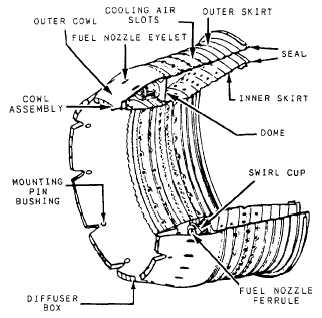engines that have a centrifugal compressor. The
annular and can-annular types are used on axial-
flow compressors.
The combustion chambers have presented one
of the biggest problems in gas turbines. The
extreme stresses and temperatures encountered are
not experienced in other types of internal-
combustion engines. The liners are subjected to
temperatures as high as 4000°F in a matter of
seconds.
The combustion chamber must operate over
a wide range of conditions. It must withstand high
rates of burning, have a minimum pressure drop,
be light in weight, and have minimum bulk.
The inner and outer liners or shrouds are
perforated with many holes and slots throughout
their length. Air is admitted through these holes
to protect the liner and to cool the gases at the
chamber outlet.
The through-flow passages are used in
practically all modern engine combustion
chambers. In the through-flow path, the gases
pass through the combustion section without a
change in direction.
The annular combustor liner (fig. 6-18) is
usually found on axial-flow engines. It is probably
one of the most popular combustion systems in
use. The construction consists of a housing and
liner.
On large engines, the liner consists of an
undivided circular shroud extending all the way
around the outside of the turbine shaft housing.
A large one-piece combustor case covers the liner
and is attached at the turbine section and diffuser
section.
The dome of the liner has small slots and holes
to admit primary air and to impart a swirling
motion for better atomization of fuel. There are
also holes in the dome for the fuel nozzles to
extend through into the combustion area. The
inner and outer liners form the combustion space.
The outer liner keeps flame from contacting the
combustor case, and the inner liner prevents flame
from contacting the turbine shaft housing.
Large holes and slots are located along the
liners to (1) admit some cooling air into the
Figure 6-18.—Combustor liner.
combustion space towards the rear of the space
to help cool the hot gases to a safe level, (2) center
the flame, and (3) admit air for combustion. The
gases are cooled enough to prevent warpage of
the liners.
The space between the liners and the case and
shaft housing forms the path for secondary air.
The secondary air provides film cooling of the
liners and the combustor case and shaft housing.
At the end of the combustion space and just
before the first-stage turbine nozzle, the secondary
air is mixed with the combustion gases to cool
them enough to prevent warping and melting of
the turbine section.
The annular-type combustion chamber is a
very efficient system that minimizes bulk and can
be used most effectively in limited space. There
are some disadvantages, however. On some
engines, the liners are one-piece and cannot be
removed without engine disassembly.
Turbines
In theory, design, and operating characteristics,
the turbines used in gas turbine engines are quite
similar to the turbines used in a steam plant. The
gas turbine differs from the steam turbine chiefly
6-12

